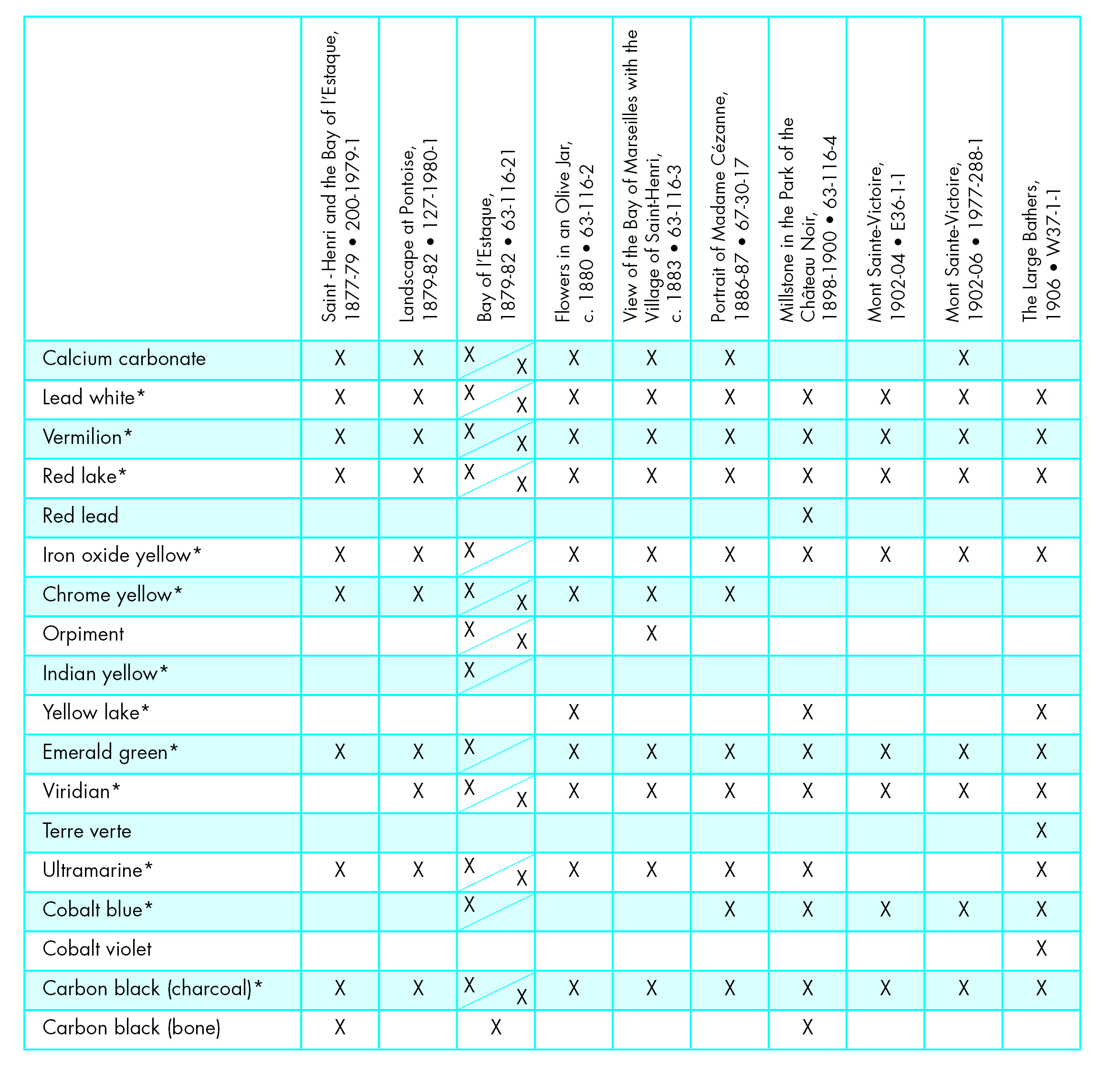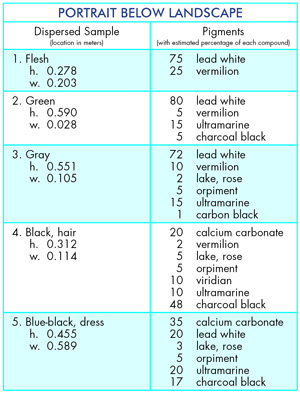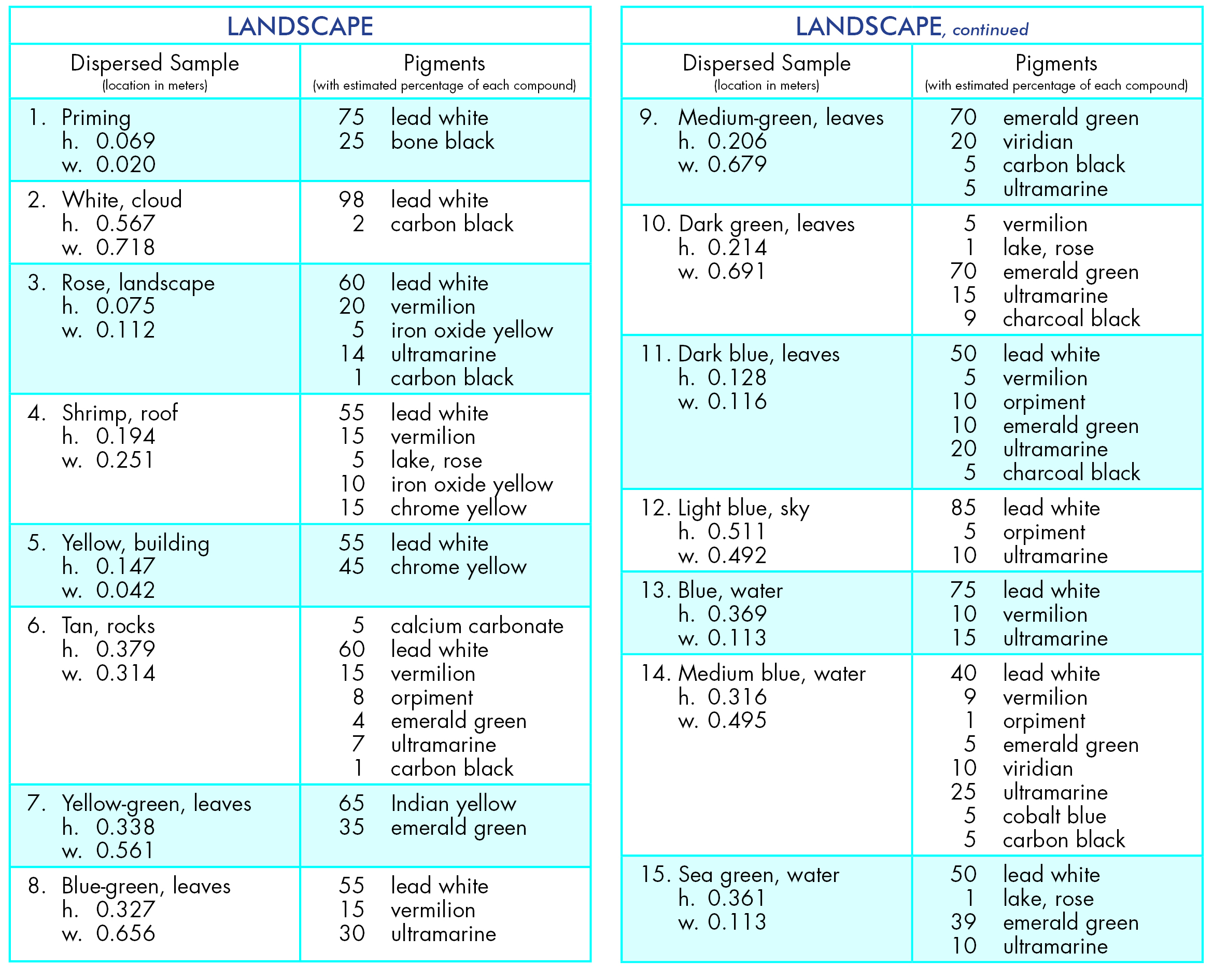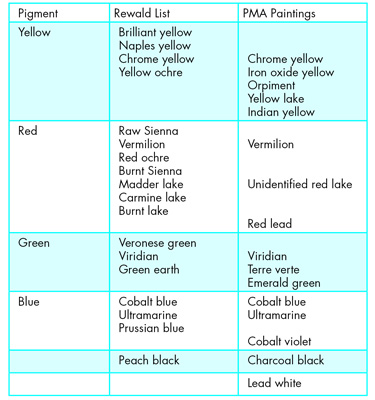An Investigation of the Materials and Technique Used by Paul Cézanne
Editors’ Note: This third article by Marigene H. Butler originally appeared as a typed preprint of a paper presented at the twelfth annual meeting of the American Institute for Conservation of Historic and Artistic Works, Los Angeles, California May 15-20, 1984. At the time of the writing of this article, Marigene H. Butler was the Head of Conservation at the Philadelphia Museum of Art, where she was responsible for planning and implementing conservation care and treatment for the entire museum collection, with a special expertise in the treatment of paintings; she retired from there in 1997. We are very pleased to have the author’s permission to publish this article, especially because it is a perfect follow-up to her second article, which described the findings of her first analysis of a Cézanne painting, and in that article she predicted the results would likely prove beneficial in documenting any changes in pigments and technique in Cézanne’s later paintings. This third article demonstrates the correctness of her prediction.
Abstract
A technical investigation of ten paintings by Paul Cézanne from the last three decades of his career, 1877-1906, documents gradual changes in his choice of pigments, and variations upon the technique of his mature style.
Introduction
During the past several years, ten major paintings by Paul Cézanne have been examined in the conservation laboratory of the Philadelphia Museum of Art. Subsequently, nine were cleaned, and structural work was carried out on two in preparation for the exhibition Cézanne in Philadelphia Collections, which was held at the museum during the summer of 1983 (1). The paintings are as follows:
Saint-Henri and the Bay of l’Estaque, 1877-79
200-1979-1
Landscape at Pontoise, 1879-82
127-1980-1
Bay of l’Estaque, 1879-82
63-116-21
Flowers in an Olive Jar, c. 1880
63-116-2
View of the Bay of Marseilles with the Village of Saint-Henri, c. 1883
63-116-3
Portrait of Madame Cézanne, 1886-87
67-30-17
Millstone in the Park of the Château Noir, 1898-1900
63-116-4
Mont Sainte-Victoire, 1902-4
E36-1-1
Mont Sainte-Victoire, 1902-6
1977-288-1
The Large Bathers, 1906
W37-1-1
This succession of examinations and cleanings provided an opportunity to look closely at the materials and technique of paintings which span the latter part of his career. Minute pigment samples as small as 25 µm were taken from the surfaces of twelve to fifteen colors in each painting. These were dispersed and mounted so that the pigments in each sample could be identified using a polarizing microscope.
Percentages of each pigment in a sample were estimated and some particle sizes were noted. Table I contains this information for one painting, Bay of l’Estaque. After the samples had been reviewed with the polarizing microscope to obtain an overview of the pigments used, additional samples were taken from areas where those pigments occurred in a nearly pure state. These were mounted for confirmation of their elemental composition by electron microprobe (2). The technique of each painting was studied with a low-power stereomicroscope, infrared reflectography, x-radiography, and cross sections mounted in solid resin.
Table 1:
Pigments Identified by Polarized Light Microscopy
in Bay of l’Estaque, 1879-83, 63-116-21
(and Portrait of Madame Cézanne
painted below landscape)
The information gathered during the investigation suggests that during the mature years of Cézanne’s career, his approach to painting involved a series of variations upon one basic technique. The variations related somewhat to whether he was painting a landscape, a portrait, or a still life, and to the scale of the composition and size of the canvas upon which he was painting. Clearly many other factors, unknown to us, influenced his approach at a given time, as this assortment of paintings reveals. The pigments, too, comprise a fairly consistent base group throughout his career. Some are dropped or used much less frequently during the last decade; others are added with several unusual occurrences.
Very little documentation exists regarding Cézanne’s working technique and even less about the materials which he used. Modern analytical techniques appear, now, to be revealing some information about his method, although it must be stressed that the present report can only be given as a beginning to such an analysis. The pitfalls and complexities of imposing any generalizations upon Cézanne’s work are deservedly famous.
Technique
In 1872-74 Cézanne lived in Auvers-sur-Oise, close enough to Pontoise where Pissarro was so that the two painters could at times collaborate in their painting. The older Pissarro’ s technique was undergoing a change at the time, and Cézanne was much influenced by him to move away from the dark colors and heavy earth tones in the spirit of Courbet which he had been using. Instead, he now began to use lighter, clearer colors, attempting to convey the effects of light and air through color. To this end he abandoned the thick, sculptural applications of paint used in his earlier work and began to apply small patches of paint of a single hue. The color changes from one patch to the adjacent one rendered every nuance of color change observed in the subject matter. Contemporary accounts indicate this method of paint application was a slow and labored process requiring much thought; as one layer was applied richly over another it was often difficult for the artist to recognize a stopping point (4).
By 1877 when Saint-Henri and the Bay of l’Estaque was painted, Cézanne had achieved a controlled evenness of handling of the paint, still with a feeling of solidity (5). This resulted from the patches of parallel strokes, often applied on the diagonal, which laid down each color in turn, brushing the edges of adjacent color patches into one another, wet into wet, thoroughly covering the canvas with paint. One is conscious of the design as a pattern with no clear definition of space. The paint appears to have been rich in medium and to have been applied with a loaded brush which permitted a succession of several parallel strokes of a given color mixture. In contrast, Landscape at Pontoise, painted a few years later, uses a similar application of color with patches of parallel strokes, but in the process defines the complicated recession of planes in space with greater clarity. Here the layers cover the canvas less heavily. The lightening process continues in Bay of l’Estaque, painted somewhere between 1879 and 1883 (6). The layer structure is complicated by the horizontal landscape’s having been painted over a vertical portrait of Madame Cézanne; examination with infrared reflectography instrumentation indicates the portrait was carried out to a fair state of completion. The face tones have been repeated in the water above. The dark blue costume has been worked into the blues and greens of the surrounding landscape and one can readily make out the location of the sitter’s shoulders and arms. Parallel strokes are especially prominent in the foreground where stronger greens and oranges have been applied with low impasto. Distant space is made lighter and airier with intermittent strokes which permit the use of the white priming of the fabric as part of the design. Cross sections show a white priming measuring 32-120 µm in thickness. Above this is the usual single layer of paint, 16-48 µm thick, in samples from two areas of foliage. A third sample of foliage has three paint layers; this includes layers from the background of the portrait below the landscape, creamy yellow, and pale gray.
The lightening of the palette and of the application of paint continues in the 1883 View of the Bay of Marseilles with the Village of Saint-Henri. Here the foreground trees are the only strong dark color. Other colors are somewhat subdued through the mixing of a large proportion of lead white into many hues, and the distant water and mountains are painted in extremely pale tones. Except for the dark greens, all of the paint is applied in more broken tones with space between strokes which serves to lighten the form and enhance the feeling of strong light. In the distance, the regular brushwork of the foreground gives way to irregular strokes which leave great areas of white priming visible to further lighten and to increase the feeling of distance. A cross-section from this dark green of the foreground trees shows a white priming 40 µm thick and a single layer of green with blue particles which measures 16-20 µm in thickness. In these paler distant areas, pencil lines are visible and infrared reflectography shows the very free drawing with which the artist laid out the composition, indicating every building and clump of trees, as well as the distant mountains. Pencil drawing has been discovered in one other Cézanne at the Philadelphia Museum of Art: the 1885-87 Portrait of Madame Cézanne #63-181-6, which has not as yet received a thorough enough examination to be included in this discussion.
Some aspects of the technique used in Flowers in an Olive Jar, c. 1880, are different from the landscapes described earlier. While the background is painted with patches of parallel strokes of varying colors which allow the priming to show in places, the paint of the flowers is applied heavily, with each stroke depicting a petal, and sometimes buildup of several layers in a petal.
The Portrait of Madame Cézanne, 1886-87, has been painted with a lighter, more airy technique overall than seen before among the works examined. Thin paint mixtures have been applied in patches of parallel diagonal strokes in some places, e.g. on the cheek where peach, pink, and rose tones depict form. Elsewhere, for example in the background, the paint has been applied in washes and perhaps rubbed with a cloth to blend adjacent colors into one another. Again the white priming is used as part of the design, here as a highlight tone in the hair.
The landscapes of the last decade use the techniques already noted but each has its own unique characteristics. In Millstone in the Park of the Château Noir, 1898-1900, the familiar parallel strokes on the diagonal and a patch for each different color are used to paint the foliage in the background, but the foreground is handled differently. In the rocks, form is modeled by blending one tone smoothly into another, for example shrimp into peach into light gray into mauve into dark gray, all within a 1″ x 2″ area of rock. Dark lines applied to the uppermost paint surface delineate forms in the foreground and pull them forward while distant space becomes less clear in a screen of colorful brushwork. Two cross sections from an area of orange-yellow foliage in the background show a 24 µm thick white priming and a single 8-12 µm thick golden-brown layer of paint.
The paintings of Mont Sainte-Victoire of 1902-04 and 1902-06 show further variations of technique. Individual forms begin to dissolve into abstraction as short, parallel strokes lay out smaller, more sharply distinct patches of color that emphasize the surface plane rather than the depth of space. It appears that a one-quarter inch wide brush may have been used to paint the foreground and a one-half inch wide brush for the distant sky and mountain. Two cross sections from green trees in E36-1-1 have a white priming 8-32 µm in thickness and an unusual succession of layers of paint: bright green, golden yellow, and bright green, each layer averaging about 40 µm in thickness. These indicate more overlapping of paint layers than was seen in the other paintings examined.
The Large Bathers, 1906, is thought to have been what Cézanne was working on when he died and is probably unfinished (7). The familiar technique is used with parallel diagonal strokes about one-inch long, creating patches of color. A one-half inch wide brush seems to have been used and the medium-rich oil paint was applied generously with a buildup of paint at the beginning of each stroke which overlaps the end of the preceding patch of strokes. The unvarnished paint is, at present, matte in appearance in spite of its medium-rich fluidity at the time of application. It appears that forms may have been laid out in black strokes of paint, followed by the application of color, then additional dark strokes painted last to further delineate form.
Pigments
The pigments observed with the polarizing microscope in these ten paintings are as follows:
Chalk (calcium carbonate), CaCO3
Lead white (basic lead carbonate), 2PbCO3•Pb(OH)2
Vermilion (mercuric sulfide), HgS
Red lead (red tetroxide of lead), Pb3O4
Red lake, unidentified organic dye
Iron oxide yellow (hydrated ferric oxide), Fe2O3•H2O
Chrome yellow (lead chromate), PbCrO4
Orpiment (sulfide of arsenic; arsenic sulfide), As2S3
Indian yellow (magnesium salt of euxanthic acid), C19H16O11Mg•5H2O
Yellow lake, unidentified organic dye
Emerald green [Paris green, Veronese green, Schweinfurt green] (copper(II)acetoarsenite), Cu(C2H3O2) 2 • 3Cu(AsO2)2
Viridian (hydrous oxide of chromium), Cr2O3•H2O
Terre verte or green earth, Fe, Mg, Al, K, hydrosilicate
Ultramarine (sulfur containing sodium aluminum silicate) Na6-10A16Si6O24S2-4
Cobalt blue (cobalt aluminate), CO•A12O3
Cobalt violet (anhydrous cobalt phosphate and/or arsenate), Co3(PO4) 2 and/or Co3(AsO4)2
Charcoal black, C
Bone black, C+Ca3 (PO4)2
Table II lists the pigments as they occurred in each of the ten paintings:
Table II:
Pigment Occurrences

A number of patterns emerged from the study of individual samples. Lead white, vermilion, emerald green, and ultramarine occur most frequently and in the most significant proportions. This correlates with findings reported to the Art Institute of Chicago in 1972 (8) from the analysis of pigments in Cézanne’s Chestnut Trees of 1885-87. Red lake, iron oxide yellow, viridian, and a carbon black also occur in most of the ten paintings, but usually in less consequential amounts. Chrome yellow is the major component of several samples, e.g. 45 percent of a yellow building in Saint Henri and the Bay of l’Estaque, or 95 percent of a flower in Flowers in an Olive Vase. Often, however, only a few particles are present in the samples in which it occurs and it disappears completely from the palette during the last decade. Cobalt blue appears in the last five paintings and is the only blue used in the two paintings of Mont Sainte-Victoire.
Carbon black particles with the jagged shapes of charcoal were present in all but one painting’s design mixtures; and particles shaped more consistently like bone black could be seen in the primings of four paintings. Calcium carbonate occurs in small quantities in scattered paint mixtures and three times as 5 percent of a priming. It also occurs in the portrait of the lower design of Bay of l’Estaque as 20 percent of the black hair and 25 percent of the blue-black dress.The reasons for this are not clear; but the effect, particularly in the hair, was to add an unusual amount of bulk and texture to the paint as it was brushed on. The resulting texture of the brushwork ensures that Madame Cézanne’s head will always be somewhat visible, in relief as well as in color, through the water of the bay which was painted over her later. Similarly, the bright yellow in Millstone in the Park of the Château Noir consists of about 47 percent calcium carbonate, here with iron oxide yellow.
Indian yellow is 65 percent of the yellow-green trees in Bay of l’Estaque; this identification is supported by the large percentage of magnesium in the electron microprobe analysis. Particles resembling terre verte appear in the dark blue of The Large Bathers. Particles with the unique polarization colors of orpiment could be seen in six samples in Bay of l’Estaque, three each in the upper and lower designs in 1-10 percent, and 1 percent each in two samples in View of the Bay of Marseilles with the Village of Saint-Henri. A few particles (5 percent) which appeared to have the polarization colors of red lead were visible in the bright red-orange of Millstone in the Park of the Château Noir. The gray and the black samples from The Large Bathers each had a few (2 percent) particles showing the distinctive characteristics of cobalt violet. The identifications of terre verte, orpiment, red lead, and cobalt violet by polarized-light microscopy have not as yet been supported by other means of analysis, largely due to the minute quantities present and the difficulty of separating out individual particles for analysis.
One question remains unresolved in the pigment identifications; that is, what appears to be a mixture of iron oxide yellow and isotropic, semi-transparent bright lemon yellow particles which may be a yellow lake (9). This mixture can be seen in:
- Flowers in an Olive Jar in the orange-brown of a yellow flower and in the dark brown of the table below the vase;
- Millstone in the Park of the Château Noir in the reddish brown; and
- The Large Bathers in the brown sample.
In cross section this mixture looks like a golden brown, semi-transparent particulate layer. The electron microprobe analysis supports the theory of iron oxide yellow and yellow lake, but further study is needed to fully understand the occurrence. (10)
Except for The Large Bathers, all of the paintings have what appear to be single-layered proprietary primings, probably applied commercially before Cézanne purchased the canvas. The primings consist mainly of lead white, although it is the sole pigment in only two cases. Three other primings have 5 percent chalk and two of these also have 1-2 percent iron oxide yellow. Five primings contain black pigment ranging from 1 or 2 percent to 10 percent in Saint-Henri and the Bay of l’Estaque and 25 percent in Bay of l’Estaque. Both of the latter primings are grayed in tone. The Large Bathers has a creamy lower priming, probably proprietary, colored with 5 percent vermilion and 10 percent black. Over this lies a pale gray layer, 5 percent charcoal black in lead white, probably applied after stretching the fabric only under the area covered by design.
In general, an individual pigment has fairly much the same characteristics from one painting to the next, wherever it occurs. The ultramarine, for example, is clearly an artificial ultramarine throughout with rough surfaced, irregularly-shaped, medium-blue particles which measure 3-4 µm in diameter. Vermilion, however, occurs in several different forms. Many samples look like dry process vermilion with scattered particles showing the characteristic bright orange-yellow polarization colors. The four landscapes dating from 1877-83 have vermilion with a wide range of particle sizes; ranging from 3-8 µm. In contrast, in the Portrait of Madame Cézanne‘s peach and orange flesh tones, tiny uniformly-sized particles of vermilion measure 1-2 µm. The bright pink flesh tones in the same painting have vermilion in larger chunks, 1-8 µm. Renoir, in 1916, used similar juxtapositions of vermilion particle sizes in his flesh tones (11). Similarly, in Bay of l’Estaque, in the peach flesh tones of the portrait below the landscape, vermilion occurs in 1-3 µm particles. The smaller particle-sized vermilion may be wet process vermilion with characteristic uniformly small particles or may simply be dry process vermilion ground fine. The two late Mont Sainte-Victoire paintings and The Large Bathers also have only vermilion with uniformly small particles in the 0.5 µm range.
The red lakes in most of the earlier paintings appear as isotropic, semi-transparent particles in varying shades of pink or rose. In Flowers in an Olive Jar and Millstone in the Park of the Château Noir the lake particles are a darker purple-red and appear to have birefringent orange polarization colors overall.
The samples from the ten paintings reveal a consistency of approach to mixing paint throughout the three decades. When one sees these paintings hanging together in an exhibition, one notes a uniform harmony of tones which is enhanced by similarities in the way paint has been applied to canvas. Part of the harmony of tones within each painting may result from the fact that a large proportion of lead white is the basis for many of the paint mixtures. For example, in View of the Bay of Marseille and the Village of Saint-Henri, the brightest red consists of 45 percent lead white softening the 50 percent vermilion. The light yellow-green of the trees is 70 percent lead white with 20 percent emerald green, and the medium blue of the water is 60 percent lead white and 30 percent ultramarine.
Cézanne’s fairly complicated paint mixtures may also contribute to the soft harmony of colors within a composition. Generally five to seven pigments occur in a given color. The lighter, brighter pinks, roses, and yellows may have fewer pigments in a mixture, and the mauves and browns have more. An exception to this number is Millstone in the Park of the Château Noir where most of the mixtures are more complex; the reddish brown and the dark blue-green colors each contain eleven pigments. In all the paintings the greens contain simple mixtures. Medium greens may be 100 percent emerald green; light greens result from lead white added to emerald green and dark greens have a little viridian added to emerald green.
The addition of black pigment may also serve to subdue the tone of a mixture. Nearly a third of the samples in the earlier paintings contain 1-5 percent of a carbon black pigment. In the late paintings a large percentage of the samples contain 1 percent or 5 percent or 10 percent carbon black.
Conclusion
It is interesting to compare the pigments which have been observed in this investigation with the palette which John Rewald assembled from Cézanne’s correspondence with Émile Bernard and memos found in the painter’s notebooks (12) as follows:
Much remains to be done in correlating the pigments observed in the Philadelphia paintings with available documentation. Hopefully, this investigation will serve as a first step in documenting the gradual changes in Cézanne’s choice of pigments and some of the variation in his technique during the last three decades of his career.
Notes
- Mark Tucker and Albert Albano were co-collaborators with the author in the treatment project; their observations about materials and technique have been extremely helpful. Suzanne Penn and Steven Erisoty assisted with the treatments; Jean Rosston and Richard Wolbers helped greatly with sample preparation and interpretation. All of us worked closely with the originator of the exhibition, Joseph J. Rishel, Curator of European Painting Before 1900 at the Philadelphia Museum of Art.
- McCrone Associates, then in Chicago, Illinois; now in Westmont, Illinois, carried out the electron microprobe analyses.
- John Rewald, Paul Cézanne, A Biography (New York, 1948), pp. 94-96.
- See Rewald, 1948, cited above, p. 63.
- Joseph J. Rishel, Cézanne In Philadelphia Collections (Philadelphia, 1983), p. 10.
- See Rishel, 1983, cited above, p. 19. The dates used in this paper follow the exhibition catalog; no attempt has been made, given the relatively few paintings sampled, to speculate about chronology.
- See Rishel, 1983, cited above, p. 47.
- Marigene H. Butler, “An Investigation of Pigments and Technique in the Cézanne Painting, Chestnut Trees“, Bulletin of the American Institute for Conservation of Historic and Artistic Works, vol. 13, no 2 (1973), pp. 77-85.
- The author was first alerted to the possible occurrence of yellow lake in Cézanne’s painting by Mr. Ashok Roy of the Scientific Department of the National Gallery of Art, London, and to a seemingly similar occurrence of yellow lake with iron oxide yellow via private communication from Mr. Roy in 1983.
- Rutherford J. Gettens and George L. Stout, Painting Materials, A Short Encyclopaedia, (New York, 1966), p. 134. In a discussion of yellow ochre, the authors note that in the recent past it was occasionally brightened with chrome yellow or natural or aniline dyes.
- Marigene H. Butler, “Technical Note 11 , Paintings by Renoir”, (Chicago, 1973), pp. 208-214.
- See Rewald, 1948, cited above, p. 202.













Comments
add comment